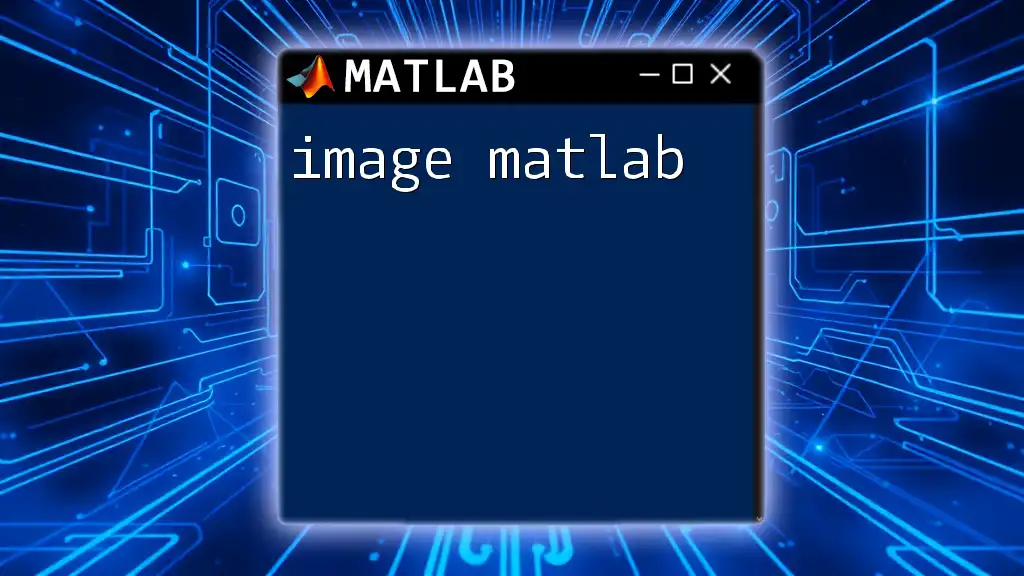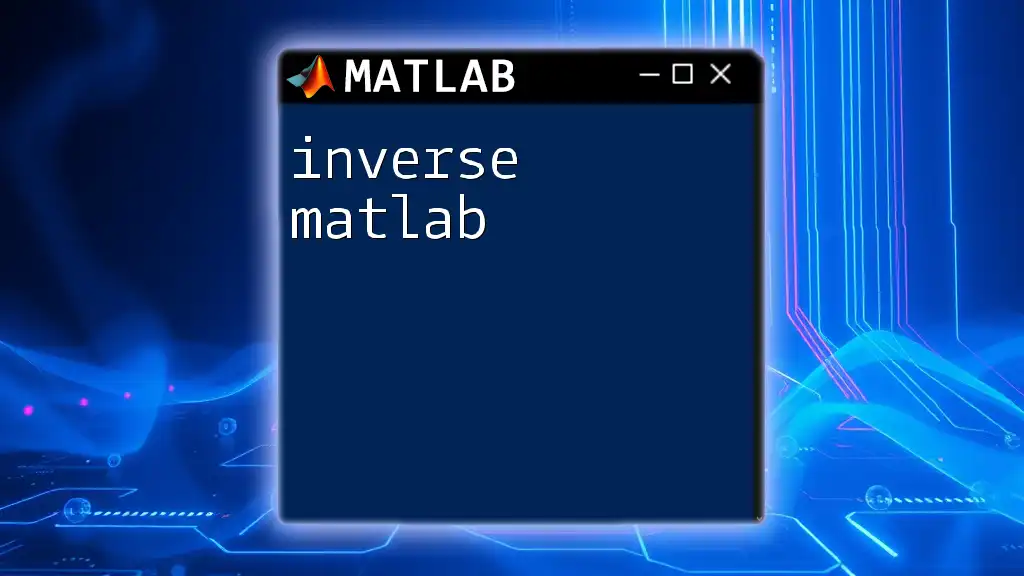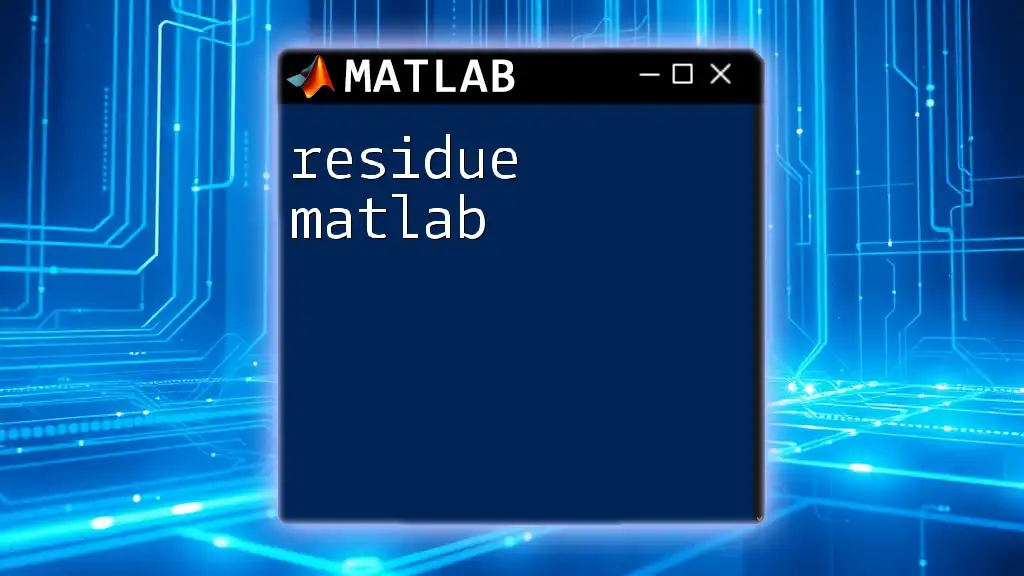The "impulse" function in MATLAB is used to compute and plot the impulse response of a dynamic system, which helps to analyze how the system reacts to a sudden input.
Here's a simple code snippet to illustrate how to use the impulse function:
% Define a transfer function for the system
num = [1]; % Numerator coefficients
den = [1, 3, 2]; % Denominator coefficients
sys = tf(num, den);
% Plot the impulse response
impulse(sys);
grid on;
title('Impulse Response of the System');
Understanding Impulse Function
What is an Impulse Function?
An impulse function is a mathematical construct used primarily in signal processing and systems analysis. It is often represented by the Dirac delta function, denoted as δ(t). This function is characterized by its ability to deliver an infinite value at a single point in time while remaining zero everywhere else.
The concept of impulse is crucial because it helps us understand how systems respond to sudden inputs, making it an essential element in the analysis of linear time-invariant systems.
Mathematical Representation
The mathematical representation of the impulse function can be expressed as:
\[ \delta(t) = \begin{cases} +\infty & \text{if } t = 0 \\ 0 & \text{if } t \neq 0 \end{cases} \]
Graphically, the impulse function appears as a spike at the origin of the time-axis, emphasizing its nature of being concentrated at one point.
Properties of the impulse function include:
- Linearity: Impulse functions can be scaled by constants and added together.
- Time-shifting: The impulse function can be altered by shifting it in time, which is essential in system responses.
Applications of Impulse Functions
Impulse functions have several notable applications. They are widely used in fields such as:
- Control Systems: To analyze how systems respond to sudden changes.
- Signal Analysis: For investigating the characteristics of various signals.
- Communications: In modulating signals and studying system bandwidth.
Through these applications, impulse functions serve as powerful tools for engineers and scientists in model development and analysis.

Impulse in MATLAB
Setting Up Your MATLAB Environment
Before getting started with impulse functions in MATLAB, ensure you have MATLAB installed on your computer. You can download it from the MathWorks website.
Once installed, open MATLAB and familiarize yourself with the interface, which includes the Command Window, Workspace, and Editor. This environment allows you to execute commands, visualize results, and create scripts.
Creating an Impulse Signal
Using the `impulse()` Function
MATLAB provides a convenient function called `impulse()` for analyzing system responses. This function can be used directly on transfer function models. Here’s how to use it:
Syntax of the `impulse()` function:
impulse(sys)
Where `sys` represents the system you are analyzing.
For example, let's define a transfer function and visualize its impulse response:
sys = tf(1, [1, 2, 1]); % Example transfer function
impulse(sys);
This command generates a graph showing the system's response to an impulse input.
Customizing Impulse Signals
Creating a custom impulse signal in MATLAB involves designing a zero vector and placing a spike at the desired time point, typically t = 0:
t = 0:0.1:10; % Time vector
x = zeros(size(t)); % Initialize a zero vector
x(t==0) = 1; % Create an impulse at t = 0
stem(t, x); % Plot the impulse
title('Custom Impulse Function');
xlabel('Time (s)');
ylabel('Amplitude');
In this example, we create a discrete impulse function that can effectively illustrate the characteristics of an impulse in a simulated environment.
Visualizing Impulse Responses
Impulse Response of Systems
The impulse response of a system is a critical property that reveals how the system reacts to an instantaneous input. To visualize this response in MATLAB, we can employ the `impulse()` function as previously described.
For instance, to analyze and plot the impulse response of our defined transfer function:
[y, t] = impulse(sys); % Retrieve the impulse response
plot(t, y); % Plot the response
title('Impulse Response of the System');
xlabel('Time (s)');
ylabel('Response');
This output provides insight into how the system behaves over time after receiving an impulse, vital for stability analysis.
Comparing Impulse Signals with Other Signals
Comparing Impulse and Step Functions
In addition to impulse functions, MATLAB enables us to investigate step functions, which provide a different perspective on system reactions. For example, we can visualize both responses together:
figure;
subplot(2, 1, 1);
step(sys); % Step response
title('Step Response');
subplot(2, 1, 2);
impulse(sys); % Impulse response
title('Impulse Response');
This comparison highlights the difference between how systems react to sudden versus gradual changes, showcasing the work of impulse functions.
What’s the Difference Between Continuous and Discrete Impulse?
The distinction between continuous and discrete impulse signals is significant in evaluating system responses. A continuous impulse function is represented mathematically, while a discrete impulse is typically used in digital signal processing.
To create a discrete impulse signal in MATLAB, you can use the following code:
n = 0:10; % Discrete time steps
x = [1, zeros(1, length(n) - 1)]; % Discrete impulse
stem(n, x);
title('Discrete Impulse');
xlabel('n');
ylabel('Amplitude');
This representation helps in understanding how various systems operate with discrete data inputs.

Advanced Topics
Impulse Response in Control Systems
In control systems, understanding the impulse response facilitates stability assessment. By analyzing how different systems react to an impulse, engineers can make informed decisions about system design.
MATLAB’s Control System Toolbox provides robust commands for analyzing system performance based on impulse input. Using a transfer function model effectively reveals critical performance metrics.
Spectral Analysis of Impulse Signals
An advanced analysis technique involves applying the Fourier Transform to the impulse function. This process helps in understanding the frequency components present in the signal, important for applications such as filtering and signal recovery.
You can perform a spectral analysis in MATLAB using the Fourier Transform as follows:
X = fft(x); % Fourier transform
plot(abs(X)); % Magnitude plot
title('Spectral Analysis of Impulse Signal');
This code snippet demonstrates how to visualize the magnitude spectrum of a discrete impulse signal, providing insights into its frequency characteristics.

Troubleshooting Common Issues
While working with impulse functions in MATLAB, users may encounter typical errors, such as incorrect variable definitions or misconfigured systems. Always ensure that:
- All variables are initialized correctly.
- The system is appropriately defined before plotting.
If issues persist, refer to MATLAB’s documentation online or community forums, where many experienced users share solutions and tips.

Conclusion
Understanding how to effectively use impulse signals in MATLAB is vital for various engineering applications. By mastering the use of the `impulse()` function and exploring system responses, you can refine your analysis skills and enhance your proficiency in MATLAB.
Experimenting with the provided examples will deepen your understanding and encourage you to delve deeper into signal processing and control systems. Feel free to reach out for further questions or clarifications!

Additional Resources
For further exploration, consider consulting the following resources:
- [MATLAB Documentation](https://www.mathworks.com/help/matlab/)
- Books on Signal Processing: Providing foundational knowledge in both theory and application.
- Engage with online communities and forums like Stack Overflow or MATLAB Central to connect with fellow MATLAB users and professionals.

















